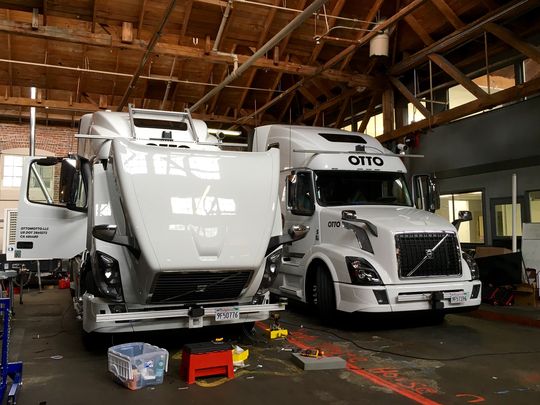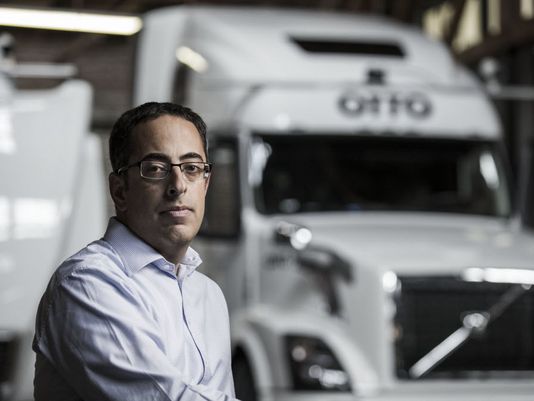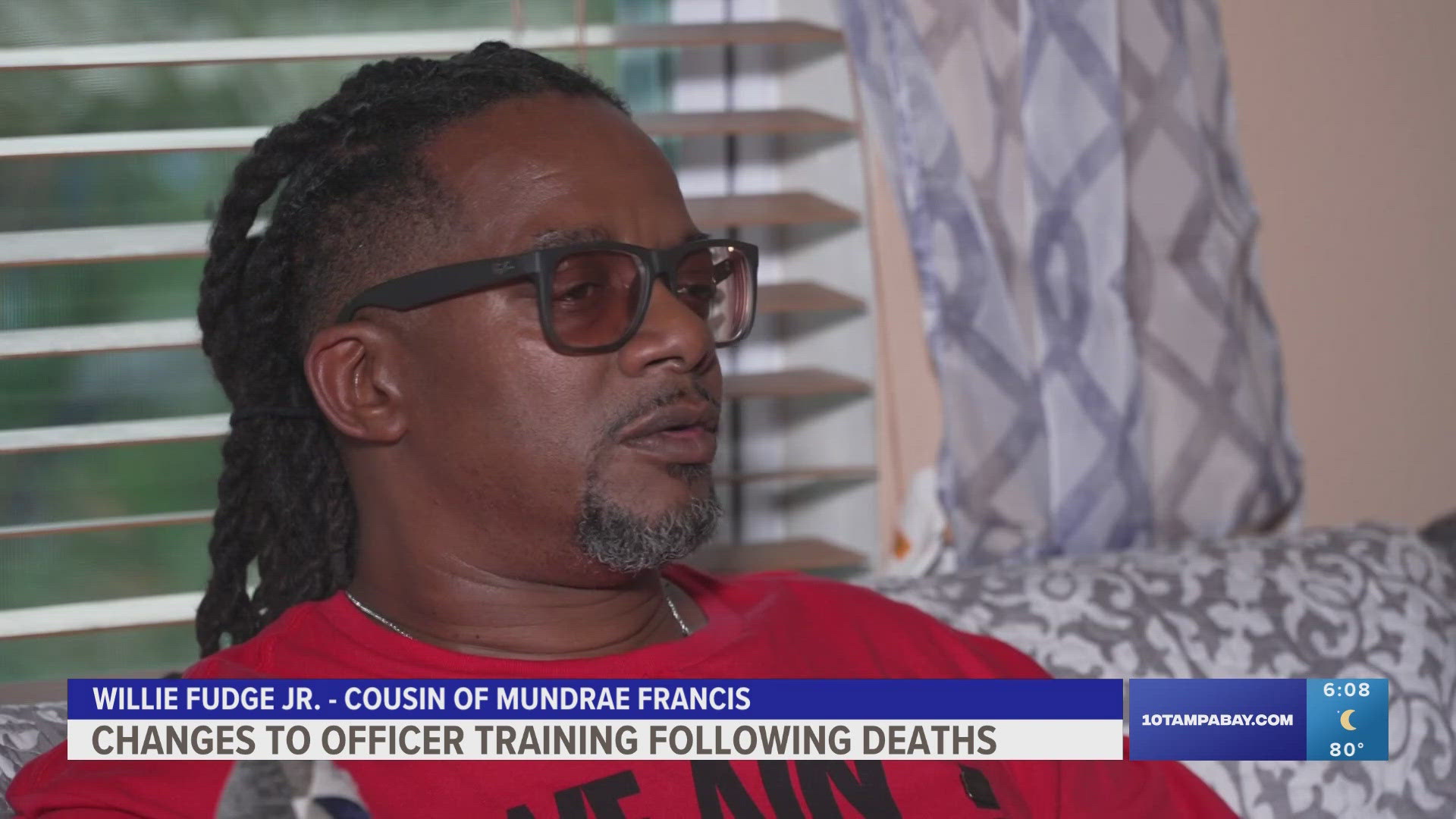SAN FRANCISCO — Walt Martin spent a decade as a long-haul truck driver, logging as many as 200,000 miles a year on the road.
Now he’s back on the highway in the driver’s seat of a Volvo big rig, cruising the 280 freeway just south of town.
Only he’s not driving — that task is being handled by self-driving truck technology built by Martin’s new employer, Otto. The 8-month-old start-up founded by Google Car veterans was just bought by ride-hailing giant Uber for $670 million.
“Fully developed, this tech will allow truck drivers to add more hours and more runs to their schedule,” says Otto test driver Martin. “Any type of efficiencies will help.”
But trucking professionals aren’t so sure. For reasons ranging from highway speeds to varying cargo requirements, trucking experts literally burst out laughing when asked about the notion of a driver sleeping while his truck barrels across a lonely state.
“Is this all intriguing and promising? Yes,” says Scott McNally, spokesman for the American Trucking Associations. “But are we skeptical? Yes.”
Much is being written about the push to develop self-driving automobiles, with tech companies and automakers alike pumping human and financial capital into the quest while promising such transportation robots by 2021.
But by focusing on automating trucks, Otto has vaulted from unknown to key player seemingly overnight. One co-founder, Anthony Levandowski, was tapped by Uber CEO Travis Kalanick to oversee the $67 billion company’s self-driving efforts.
Clearly, Kalanick saw the potential for Uber to own a piece of the massive U.S. trucking industry, which in 2015 brought in $726 billion in revenue and accounted for 81% of all freight transport, according to the American Trucking Associations.
ASLEEP AT THE WHEEL?
Otto’s mission is as simple as its tech is complex. Sometime in the coming few years, it hopes to produce an aftermarket self-driving kit consisting of radar, laser radar, cameras and computers that can be added to existing big rig cabs.
There’s no price yet, but Cruise Automation, which GM just bought for $1 billion, was charging $10,000 to add its autonomous-driving sensors to automobiles.
Once on board, all this gadgetry would bring so-called Level 4 autonomy to a truck — in other words, the driver could sleep in the back while the truck drives itself on highways. All city driving would be handled by humans.
“Often there are two questions for drivers," says Otto co-founder Lior Ron who, like Levandowski, used to work at Google. “Do you want to be safe, or do you want to make more money? And sometimes those two answers don’t add up.”
Drivers are limited in terms of the number of consecutive hours they can drive. So a parked truck is a truck not making a delivery, not earning its keep. By enabling the vehicle to theoretically hit the road all night while the driver sleeps in the cab “could get the driver to his next destination, or home to his family, faster,” says Ron.

Ford, Uber, Google and others are promising that same autonomy (Level 4 under the Department of Transportation's designations) — often in vehicles with no steering wheel or pedals — but for ride-hailing fleets plying dense urban centers.
Trucks, however, pose unique challenges.
“A truck driver has to be 100% engaged in the act of driving, scanning the horizon for that SUV that’s changing a tire on the shoulder or some idiot doing something dumb, and anything less isn’t something I want to deal with, ever,” says Scott Grenerth, regulatory affairs director for the Owner-Operator Independent Drivers Association. The association represents the estimated 350,000 owner-operators nationwide.
Grenerth, who as a trucker logged a million accident-free miles, says he welcomes any technology that enhances the safety and comfort of the trucking experience for drivers. But, he adds, "I don't see computers being able to account for every situation a trucker might experience.”
FREIGHTED WITH ISSUES
ATA spokesman McNally stresses that, depending on the type of cargo that’s being hauled, a driver might be required to constantly monitor his load’s safety. That would make going to sleep impossible. He also adds that a regulatory framework that applies to all 50 states would be critical to making interstate self-driving trucking a reality.
And then there’s the issue of jobs. “You talk about automated trucks and the topic of that being a job killer does come up with drivers,” says McNally. “We’d like to think you’ll always need a driver.”
Otto’s Ron insists that getting rid of truck drivers is not the company’s mission. “Remember, this technology works exit to exit, not really in a city, so you’ll need the driver,” he says.
Nevertheless, Ron says Otto is unabashedly focusing on Level 4 autonomy because “handing control back to the driver at the last minute in case of an emergency will not work.”
Automakers such as Ford have come to the same conclusion, pushing for full autonomy because there’s a danger in providing so much self-driving assistance that the driver is lulled into complacency and can’t retake control of the vehicle quickly.
Federal officials are currently investigating a May crash in Florida that involved an Autopilot-equipped Tesla Model S, which slammed into the side of a truck that had cut in front of the electric sedan.
CAUTION: OTTO-PILOT HITS ROAD
In the coming weeks, Otto’s half-dozen $140,000 Volvo VNL 780 cabs, which are capable of pulling 53-foot trailers, will fan out across a few states for open-road testing. Hours will be logged to dial in the various fender, wheel and roof-mounted gear.

The advantages of working on trucks include the fact that there’s more room to store the various computer componentry. Conversely, the extreme bumpiness of a truck’s ride means that those systems need to be better isolated from road harshness than their automotive counterparts.
TEST DRIVE
During USA TODAY’s short test drive, a couple of advantages over self-driving cars immediately surfaced.
For one, a self-driving car’s tendency to drive like an elderly grandparent is annoying on city streets, but the same behavior in a truck on a highway doesn't give motorists fits. While Martin’s rig stayed in its lane at a steady 55 mph, most cars simply chose to pass us.
And second, given that self-driving trucks may often find themselves virtually alone on an open highway, a system that serves as a super-sophisticated cruise control could take away some of the monotony of the driving chore.
But ultimately it's difficult to make mental the leap from driver-monitored to driver-napping trucking. Simply put, the issue of a tractor cab (weighing around 15,000 to 20,000 pounds) and its trailer (from 30,000 to 60,000) barreling down the road at 70 mph with a computer at the helm is likely to worry truckers and regular drivers alike for some time.
“I realize we are setting the bar high,” says Ron with a smile. “Once the technology is safer than driving a truck is on average, we will deploy. We understand it’s also about educating people and creating a dialog about what we’re doing. Initially it might be baby steps, but eventually, we think we’ll get there.”
Follow USA TODAY tech reporter Marco della Cava @marcodellacava


